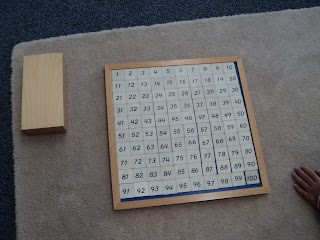Our two previous blog posts have been about the Montessori work activities that our five year olds are doing in our classrooms.
Continuing along, this blog post is about some of the Montessori work our four year olds are doing in the classrooms. These photographs were taken during the last few weeks of November. Please note that the children in these photographs are in their second year of a three year Montessori Casa (preschool) program.
The Clock ~ Teaching Time in the Classroom
E. is using the clock to learn how to tell time.
E. is removing the loose numerals for numbers 1 to 12. The blue numerals still in the box represent the numerals needed for the 24 hour clock (13 to 24).
E. is placing the numerals around the clock in the correct order.
E.'s teacher is asking her to move the clock hands to form various times. Here she has formed three o'clock. E. can also work with the clock cards to form various times.
Blue Object Boxes
The Object Boxes are materials used to introduce the child to reading. When the child begins to read words in the Montessori environment or can spell and read back words with the Moveable Alphabet, the child is able to work with the Object Boxes. (In our next blog - Catching Up with Our Three Year Olds - the Moveable Alphabet will be explained.)
The Object Boxes consist of Pink Object Boxes (two and three letter phonetic words), Blue Object Boxes (four letter or greater phonetic words with consonant blends and short vowels) and Green Phonogram Boxes (boxes which isolate double symbols such as 'ee', 'ow' etc.).
S. is working with a Blue Object Box on the table. He has set out the objects in the box - frog, lock, button, rabbit, infant, milk.
S. is reading the words and matching the words to the object. When S. matched each object with the appropriate word card, he wrote the words in his printing book and drew a picture for each. S. is also working with the Blue Object Boxes and the Moveable Alphabet to spell the names of the objects found within the box.
The Golden Bead Material ~ Introduction to the Decimal System
In our classrooms, the Golden Bead materials are in constant use. The children are attracted to them and feel that they are doing very big, important work. As a Montessori teacher, the Arithmetic materials are some of my very favourite. As someone who struggled with Arithmetic concepts in school, I finally felt that I understood Arithmetic once I had been introduced to the casa (preschool) and elementary Montessori math materials during my Montessori training.
The beauty of the Montessori Arithmetic materials is that they build sequentially on previous learning, are self-correcting, isolate the concept being learned and introduce the concrete before the abstract.
The children in these photographs have been introduced to the Golden Bead Materials and are now forming complex numbers with the Golden Beads and Large Number Cards.
Formation of Complex Numbers
E. and J. are setting out the Large Number Cards on the mat. The cards go up to 9,000 yet we are only using the 1,000 card for this exercise.
E. and J. are placing the corresponding Golden Bead materials next to each number card.
These children are working at forming and reading numbers in three categories - units, tens and hundreds. J. brings me his tray and tells me what he has on it - six units, nine tens and two hundreds.
J. then slides the individual number cards together to reveal the number of Golden Beads he has on his tray - "Two hundred ninety six".
Once the children are able to form and read large numbers into the thousands, the Golden Bead material is used to solve addition, multiplication, subtraction and division sums in all four categories of numbers.

























































